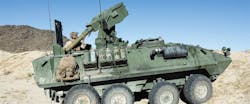Marine Corps chooses Leidos Dynetics to build new medium-range radar systems for expeditionary air defense
Summary points:
- Marine Corps selects Dynetics for six Medium Range Air Defense Radar (MRADR) systems to enhance aerial threat detection and tracking.
- MRADR capitalizes on advanced digital signal processing all-around coverage with minimal electromagnetic footprint.
- MRADR will pair with systems like G/ATOR and MRIC to protect forces from crewed aircraft, cruise missiles, rockets, and drones.
QUANTICO MARINE BASE, Va. – U.S. Marine Corps surveillance experts needed a new radar system to enhance medium-range air-defense capabilities. They found a solution from Dynetics, a Leidos company in Huntsville, Ala.
Officials of the Marine Corps Systems Command at Quantico Marine Base, Va., announced a $24.9 million contract to Dynetics last month for six Medium Range Air Defense Radar (MRADR) production-representative model systems.
MRADR aims to provide target detection with a 360-degree field of view, drawing on lessons learned from other programs like the Marine Expeditionary Long Range Persistent Sensor (MELPS), which combines digitized antennas, receivers, and digital signal processing for a high-quality air picture without a detectable electromagnetic footprint.
Marine Corps leaders say they plan to integrate MRADR with Marine Corps. existing air defense systems, such as pairing it with the AN/TPS-80 Ground/Air Task-Oriented Radar (G/ATOR), a multi-purpose active electronically scanned array (AESA) radar that offers 360-degree coverage.
Countering air threats
The MRADR is part of broader Marine Corps modernization in ground-based air defense to defend against aerial threats like helicopters, fixed-wing crewed aircraft, cruise missiles, and uncrewed aircraft.
The Marine Corps awarded a $32.1 million contract in September 2023 to Dynetics, together with the Consortium Management Group Inc. in Washington for four MRADR prototype systems. The Consortium Management Group is a nonprofit organization that manages other transaction agreement (OTA) consortia.
The Marines will use MRADR to detect, track, identify, and defeat enemy cruise missiles and other crewed and uncrewed aerial threats. MRADR system is designed to be mobile and expeditionary by integrating with missile systems like the Medium Range Intercept Capability (MRIC), which comes from Israel's Iron Dome technology.
Tell me more about expeditionary air defense ...
- Expeditionary air defense capabilities are rapidly deployable, self-sustaining, and effective in austere or forward-operating environments. These systems can range from man-portable systems to vehicle-mounted radar and missile systems for layered defense. They often include radar, command and control (C2), and interceptors in a compact networked package for autonomous or semi-autonomous operation. Expeditionary air defenses counter drones, cruise missiles, aircraft, and in some cases rocket, artillery, and mortar threats. Examples are the National Advanced Surface-to-Air Missile System (NASAMS); Medium Range Air Defense Radar; AN/TWQ-1 Avenger mobile air defense with Stinger missiles on a Humvee chassis and the expeditionary version of Iron Dome.
MRIC helps defend Marine Corps expeditionary forces and fixed sites from air and cruise missile attacks, and it can also counter artillery rockets, shells, and drones.
The radar works with missile launchers and command units in a secure wireless network. MRADR is being developed to work with transporter erector launchers on amphibious combat vehicle chassis (ACV-MRAD). The Corps retired its last medium-range system in the late 1990s.
On this contract, Dynetics will do the work in Huntsville, Ala., and in Woodlake, Calif., and should be finished by 2027. For more information contact Dynetics, a Leidos company, online at www.leidos.com/insights/dynetics, or Marine Corps Systems Command at www.marcorsyscom.marines.mil.
About the Author
John Keller
Editor-in-Chief
John Keller is the Editor-in-Chief, Military & Aerospace Electronics Magazine--provides extensive coverage and analysis of enabling electronics and optoelectronic technologies in military, space and commercial aviation applications. John has been a member of the Military & Aerospace Electronics staff since 1989 and chief editor since 1995.
